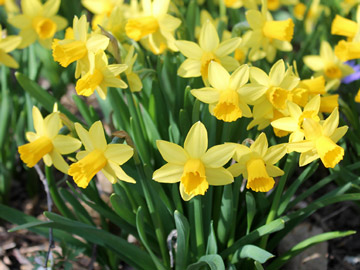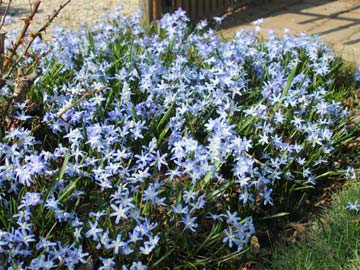 Daffodils are one of the most durable bulb choices, usually spreading with age and increasing in blooms.
Daffodils are one of the most durable bulb choices, usually spreading with age and increasing in blooms.
© George Weigel.
One of the most common questions about spring-flowering bulbs is, "Why did they stop blooming?" Or worse yet, "Where did they go?" Both mysteries apply mainly to America’s bulb of choice, the tulip, which happens to be as tasty to rodents, rabbits and deer as it is attractive to people. Most tulips also naturally fizzle with age, blooming less reliably, sending up shoots without flowers, and thinning in number with each passing year. That’s why most public gardens treat tulips as annuals and install fresh plantings each fall.
Dwindling performance also often affects hyacinths, which tend to produce "skinnier" blooms over time, and some types of crocuses, which, like tulips, are often rodent targets. But other than those few species, most spring-blooming flower bulbs are reliable performers that not only bloom every year but spread to produce increasing yield. Interested in bulbs that get better instead of worse with age? Then consider adding these eight to your spring repertoire. All are best planted in the weeks around fall’s first killing frost, which for most of the United States is late September through mid-November:
1. Daffodils (Narcissus). These are some of the earliest bulbs to emerge and bloom in spring, opening as early as late February and as late as early May, depending on type and climate. The flowers are trumpet-shaped, and yellow and gold are the two prevailing colors, although white and assorted pastels are available. Most grow 18 inches to 2 feet tall, but dwarf types stay under 1 foot. Daffodils are hardly ever bothered by animal pests.
 Glory-of-the-snow makes a colorful, low-growing mat that blooms in early spring.
Glory-of-the-snow makes a colorful, low-growing mat that blooms in early spring.
© George Weigel
2. Squill (Scilla). Not many flowers produce true-blue blooms, but this tough little bulb family does. The flowers are bell-shaped and droop downward, opening around late March to mid-April. Squill grow about 4 to 6 inches tall, aren’t eaten by animals, and colonize to make short, thick mats of color.
3. Glory-of-the-snow (Chionodoxa). Here’s another little-known bulb that colonizes well and flowers reliably year in and out. Like squill, glory-of-the-snow are short plants (4 to 6 inches) that produce dainty, star-shaped flowers of lavender, blue-purple, white or pale pink from late March into mid-April. Animals don’t like these either.
4. Snowdrops (Galanthus). These shorties with the hanging, white, bell-shaped flowers are first out of the gate, often blooming in February as soon as snow melts enough that you can see them. Snowdrops grow only about 6 inches tall and colonize into short mats, similar to squill and glory-of-the-snow – only earlier.
 This group of 'Globemaster' alliums makes a striking display and gets better with age.
This group of 'Globemaster' alliums makes a striking display and gets better with age.
© George Weigel
5. Ornamental onions (Allium). Related to the onions we eat, these bulbs are some of the most striking eye-grabbers with their rounded blooms that emerge from stiff shoots from among the strappy foliage. Some types, like the 'Globemaster' and 'Gladiator' varieties, produce flower balls nearly the size of softballs. Others look like exploding stars, and "drumsticks" types have only pinky-nail-sized flowers. Bloom colors are usually lavender or purple, although some types are white or pink. Peak bloom is May into June – the latest of the spring-blooming bulbs.
6. Snowflakes (Leucojum). You’ll find two versions of these, although both feature hanging, white, bell-shaped flowers, similar in appearance to snowdrops. Spring snowflakes grow shorter and earlier (10-12 inches in March) than summer snowflakes, which grow 18 to 24 inches tall from April into May.
7. Grape hyacinths (Muscari armeniacum). Different from the bigger and fragrant Dutch hyacinths, grape hyacinths are smaller bulbs that have the unusual habit of sending up foliage in fall but not flowering until the following spring. Grape hyacinths produce short, fat flower spikes of purple, blue-purple or white atop green, grasslike foliage. They grow about 6 inches tall, bloom from late April into early May, and colonize thickly and quickly.
8. Winter aconite (Eranthis). Only snowdrops rival this short, yellow-blooming bulb for earliness. As the name implies, winter aconite are up and flowering most years by the end of winter – sometimes as early as February. Plants grow only about 4 inches tall and colonize quickly – almost too aggressively for some gardeners’ taste. The flowers look much like sundrops.
If flowering decreases for any of the above, over-crowding or increasing shade from growing trees is usually to blame. Digging, dividing and replanting crowded clusters of bulbs usually rejuvenates them, and replanting into sunnier areas solves poor bloom due to too much shade. The two best times to move and/or divide bulbs are right after the foliage turns brown in spring and in early fall – if you can find the dormant bulbs then without slicing through them with your shovel while digging. All bulbs also appreciate fertilizer twice a year in early spring and early fall with a granular fertilizer formulated for bulbs.